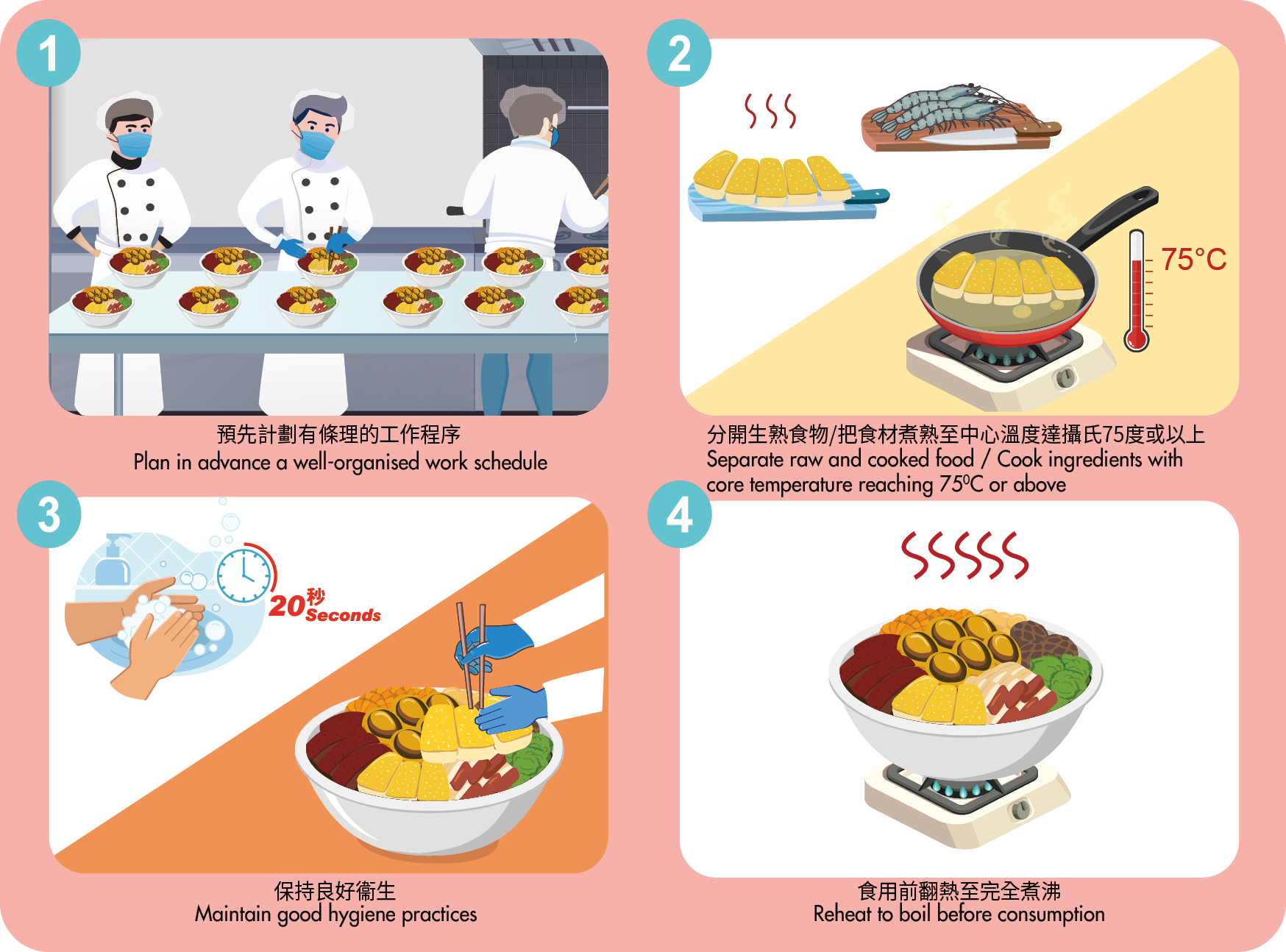
Food Safety Focus (176th Issue, March 2021) – Incident in Focus
Love It or Loathe It: Poon Choi and Its Microbiological Risks
Reported by Mr. Chi Keung SO, Chief Health Inspector,
Risk Communication Section, Centre for Food Safety
While dining out has become a less popular option lately, home feasts are blooming with the aid of online ordering and door-to-door food delivery services. All walks of local eateries ranging from fine-dining restaurants to fast food chain stores, large or small, have jumped on the bandwagon to offer takeaway Poon Choi as a substitute for holding a family banquet in a restaurant. Occasionally, however, this local delicacy is still reported to be associated with food poisoning.
A Case Study
About two weeks before the 2021 Lunar New Year, one suspected food poisoning case related to Poon Choi was reported. Ten persons were affected after consuming a takeaway Poon Choi and other hot dishes purchased from a licensed eatery in Hung Hom. The suspected causative agent was Salmonella species. Although the licensed restaurant has been in operation for more than a decade, it was its debut for selling Poon Choi since December last year.
Figure 1: Measures to reduce the risk of Poon Choi
Site investigation revealed that the same pair of chopsticks was used by food handlers for both beating raw eggs and transferring cooked food ingredients onto the Poon Choi, and that there was not any further heat treatment step in preparation of the Ponn Choi. While handling cooked and raw food at the same time, the food handlers did not practise proper hand hygiene as no liquid soap was available beside the wash-hand basin in the food preparation room. Cross-contamination of the chicken in the Poon Choi by the food handlers and utensils, together with insufficient reheating of the Poon Choi before consumption by the victims, are contributing factors to the food poisoning.
What Makes Poon Choi High Risk?
Poon Choi contains various kinds of food ingredients which are susceptible to contamination if not properly handled. The sudden increase in number of orders during festive occasions creates capacity issues. While an underpowered kitchen certainly puts food safety into jeopardy, recruiting temporary food workers may not be better off should they not receive adequate and proper training.
Preparing a considerable quantity of different food ingredients too far in advance, repeated handling of ingredients like chopping of poached chicken and prolonged storage at room temperature before delivery or collection can all put Poon Choi to the risk of cross-contamination as well as bacterial growth. Poon Choi inadequately reheated before consumption together with the factors mentioned above, are the perfect recipe that makes Poon Choi a high risk dish.
Key Points to Note
- Poon Choi is a high-risk food due to its complex, labour-intensive and time-consuming production.
- Preparing different types of food in bulk within a short period of time, compounded with underequipped facilities and inadequate manpower, render Poon Choi prone to higher risks of cross-contamination.
- Safe temperatures for thorough cooking and reheating Poon Choi are the key to food safety.
Advice to the Trade
- Plan carefully in advance to secure adequate manpower, space and equipment for making Poon Choi. A well-organised work schedule can help prevent cross-contamination.
- Train temporary food workers before operation to make sure that they are familiarised with the working environment and adhere to safe food preparation practices.
- Maintain good hygiene practices. Wash hands for at least 20 seconds before handling cooked food to reduce the risk of food contamination.
- Cook all ingredients thoroughly with the core temperature reaching 75°C or above for at least 30 seconds.
- Provide written consumption instructions to remind customers of the proper method of storing Poon Choi if not for immediate consumption, i.e., keep hot Poon Choi at above 60°C and chilled Poon Choi in the refrigerator at 4°C or below, and thorough reheating before consumption.
Advice to Consumers
- Purchase Poon Choi from reputable licensed suppliers.
- Reheat the Poon Choi thoroughly until its core temperature reaches 75°C or above, or to a complete boil before consumption. The required reheating time increases with the size of Poon Choi. Cover the container during reheating to achieve thorough heating of all the ingredients.
- Consume the Poon Choi as soon as possible once received, and finish the reheated Poon Choi in one go.

